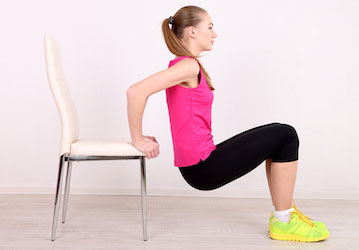At-home workouts can be tough to put together, especially if you don’t have a lot of gym equipment on hand. It can be even harder during deployment. A good place to start is to determine your fitness goals. Are you looking to improve your muscular strength or endurance? Do you want to be able to run further or faster? Next, review the training principles that will help you meet those goals and perform at your best.
Muscular endurance
You’ll need to use light weights and high repetitions to improve muscular endurance. Body-weight exercise is a great way to improve your muscular endurance, especially if push-ups and sit-ups are part of your physical fitness test. Muscular endurance is the component of muscular fitness that will be the easiest to train when you’re confined to your home or deployed setting with limited gym equipment.
Muscular strength
Building muscular strength requires using heavier weights and fewer repetitions, making it a bit more difficult with limited equipment. You’ll also have to get creative if you don’t have access to a traditional gym facility. If you’re on deployment and don’t have much, use what you have on hand. For example, pounding a truck tire with a sledge hammer is a great way to improve core stability while working through a challenging functional movement. You can also load up a rucksack and do a bodyweight exercise routine of squats, lunges, pull-ups, and other exercises from the foundational movement series. The added weight from the ruck or other equipment can help build muscular strength.
Cardiorespiratory endurance
The good thing about working out to improve cardiorespiratory endurance (CRE) is that you don’t need any equipment. For those with injuries that make it tough or painful to run, try dancing, moving a little faster when performing yard or housework, or climbing stairs for 30 minutes a day. Otherwise, this is one area where you will need access to a bicycle, stationary bike, or pool to get your cardio in. The key to training CRE is to get your heart rate up for close to 30 minutes a day, 5 days a week, or for a combined total of 150 minutes. Shorter durations won’t be as effective, and not reaching the goal of 150 minutes of physical activity will make it difficult to stay fit, healthy, and prepared for your annual fitness test.
Desk workouts
Desk workers are often looking for tips on how to get active during the workday. Trying to break up the time spent sitting during the day can have many health benefits because sitting time has been linked to risk of chronic diseases and early death. The only way to offset the amount of time sitting for work, however, is to stay active and get your heart rate up. Body-weight exercises for desk-based workouts are good for improving low levels of muscular strength and endurance, and stretches can help reduce the pain from sitting. But in order to get your heart rate up, you’ll probably break office etiquette when doing a high-intensity plyo workout at your desk.
Homemade fitness
Find common household items that can help maintain your fitness routine at home too. Or reuse balls or bottles to boost strength and reduce waste to do your part to protect the environment. Try these DIY home-exercise hacks for a full-body workout that’s convenient and easy on your wallet!
- Do calf raises, single-leg raises, or squats on your stairs.
- Use a sturdy chair for tricep dips, step-ups, push-ups, or squat jumps.
- Practice ab rollers with a hand or kitchen towel on your tile or hardwood floors, or switch to paper plates for use on a carpet.
- Fill a gallon (or half-gallon) jug with sand to desired weight and use it for bicep curls, overhead presses, or tricep extensions.
- Use a 72-oz detergent bottle—weighing about 5 lbs—for 2-handed lifts such as shoulder raises or sumo squats.
- Fill water bottles with sand or water and use them for a variety of dumbbell-weight exercises, including bicep curls, weighted lunges, and shoulder presses.
- Make a medicine ball: Cut a slit in a basketball or soccer ball, fill with sand, and seal.
Remember there are clever ways to work out—whether you’re on or off duty. Check out HPRC’s videos below to learn more home-exercise hacks.
Other resources
The Navy Operational Fitness and Fueling System (NOFFS) and Army Field Manual (on physical readiness training) exercises were designed to be performed with little to no equipment aboard Navy ships and in austere settings. Use these resources for several pre-programmed, limited-equipment workouts to stay fit if you don’t have access to a full gym.
